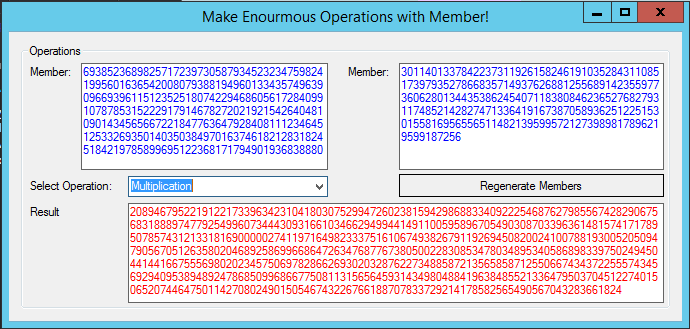Introduction
Have you ever wanted to overcome integer boundaries? If at least one time had you thought of multiplying or dividing a million digit by another, you're welcome. You're at the right place. You will make easy use of the TMember type: a Member object.
Code Usage
m1 = TMember.FromString(txtTerm1.Text, new TRadix(10));
m2 = TMember.FromString(txtTerm2.Text, new TRadix(10));
uint n = 543215;
TMember m3 = TMember.FromInt(n, new TRadix(10));
uint[] data1 = new uint[456];
uint[] data2 = new uint[456];
for (int i = 0; i < 456; i++)
{
data1[i] = (uint)(i * i);
data2[i] = (uint)(i * i%17);
}
m1 = TMember.FromData(data1, new TRadix(uint.MaxValue));
m2 = TMember.FromData(data2, new TRadix(uint.MaxValue));
TMember mhex = TMember.FromString("4321543254362", new TRadix(16));
TMember mbinary = mhex.ToDecimal().DecimalToRadix(new TRadix(2));
public static TMember operator +(TMember term1, TMember term2)
public static TMember operator +(TMember term1, TDigit term2)
public static TMember operator -(TMember term1, TMember term2)
public static TMember operator -(TMember term1, TDigit term2)
public static TMember operator *(TMember term1, TMember term2)
public static TMember operator *(TMember term1, TDigit term2)
public static TMember operator /(TMember term1, TMember term2)
public static TMember operator /(TMember term1, TDigit term2)
public static TMember operator %(TMember term1, TMember term2)
public static TMember operator %(TMember term1, TDigit term2)
public static TMember operator <(TMember term1, TMember term2)
public static TMember operator <(TMember term1, TDigit term2)
public static TMember operator >(TMember term1, TMember term2)
public static TMember operator >(TMember term1, TDigit term2)
public static TMember operator <=(TMember term1, TMember term2)
public static TMember operator <=(TMember term1, TDigit term2)
public static TMember operator >=(TMember term1, TMember term2)
public static TMember operator >=(TMember term1, TDigit term2)
public static TMember operator ==(TMember term1, TMember term2)
public static TMember operator ==(TMember term1, TDigit term2)
txtResult.Text = "" + (m1 * m2) % TMember.FromString("54366");

- It is so easy to initialize a Member object:
- Now you can initialize your Member instance with various radixes, like this one:
- You can also make conversion of different radixes to or from decimal using the
ToDecimal and DecimalToRadix methods. They're public now: - I implemented nearly all operators valid for integers:
- And you can make use of it:
- The result is simple to see; not so easy to evaluate, however:
Architecture

return SCalculator.Comparer.Gt(term1, term2);
uint n = 3;
n = SValidator<uint>.Validate(num => num > 10, n);
numstr=SValidator<string>.Validate(s => s.All<char>(ch => Char.IsNumber(ch)), numstr);
I love it 

- The code architecture could be summarized as below:
- In the
Arithmetics namespace, the SCalculator class is the transition layer to the outside of the namespace. It initializes all TAdder, TComparer etc. classes as static object instances and Types classes make use of them like this: - As you can see, this code compares two values if
term1 > term2 and returns the result. - The
Types namespace has these core types for Member:
TMember: main entry classTDigit: represents one digit of a number (with any radix)TRadix: represents radix for digit and memberESigns: for now, this enumeration is orphan
- The
Constraints namespace is my favorite. Imagine a validator of any type making checks and returning the checked type in one line of code: - This line of code validates n if it is greater than or equal to (>=) 0 (now that is false because n=3). If not, it throws an exception. And here is a some more complicated example (trick: you can check if the string has only decimal digits):
- There is also another class
TSelfValidator<TType> to validate derived classes, but that's enough explanation. If you're still with me, I appreciate your patience. Don't get afraid. I am almost finished.
Last Word
- I strongly advice you to look over my code if you're interested in using it. Mathematics imply. Computers reply.
History
- 2015.07.18 This version fixes division error.
- 2013.04.15 This version fixes not starting error. And adds start over button.
- 2011.06.11: This version supports radix conversion using the
DecimalToRadix and ToDecimal methods.
- 2011.06.10: This version does not provide support for floating number implementation. m1 / m2 simply returns m1 // m2 (true div: remainder trimmed).
